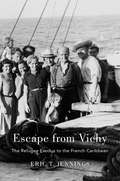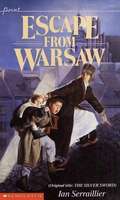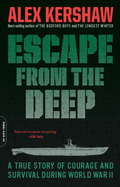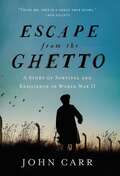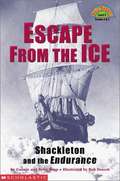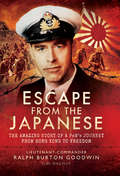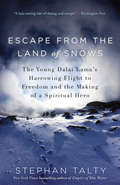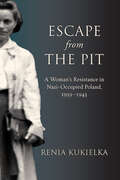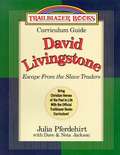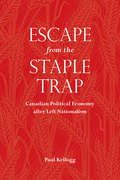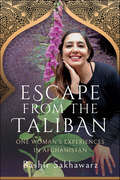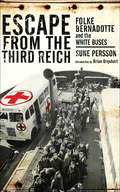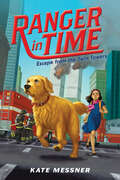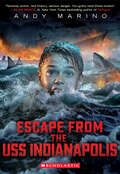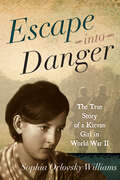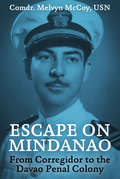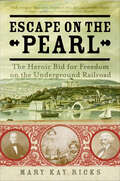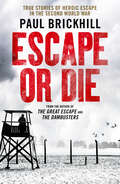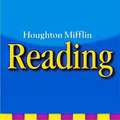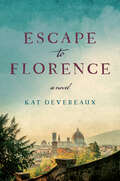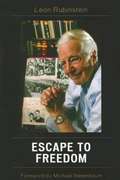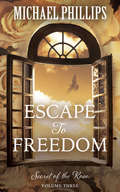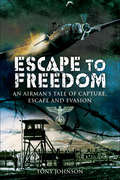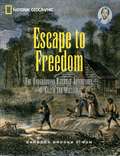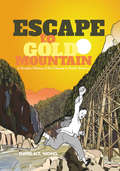- Table View
- List View
Escape from Vichy: The Refugee Exodus to the French Caribbean
by Eric T. JenningsIn the early years of World War II, thousands of political refugees traveled from France to Vichy-controlled Martinique in the French Caribbean, en route to what they hoped would be safer shores in North, Central, and South America. While awaiting transfer from the colony, the exiles formed influential ties—with one another and with local black dissidents. Escape from Vichy recounts this flight from the refugees’ perspectives, using novels, unpublished diaries, archives, memoirs, artwork, and other materials to explore the unlikely encounters that fueled an anti-fascist artistic and intellectual movement. The refugees included Spanish Republicans, anti-Nazi Germans and Austrians, anti-fascist Italians, Jews from across Europe, and others fleeing violence and repression. They were met with hostility by the Vichy government and rejection by the nations where they hoped to settle. Martinique, however, provided a site propitious for creative ferment, where the revolutionary Victor Serge conversed with the anthropologist Claude Lévi-Strauss, and the Surrealist André Breton met Negritude thinkers René Ménil and Aimé and Suzanne Césaire. As Eric T. Jennings shows, these interactions gave rise to a rich current of thought celebrating blackness and rejecting racism. What began as expulsion became a kind of rescue, cut short by Washington’s fears that wolves might be posing in sheep’s clothing.
Escape from Warsaw
by Ian SerraillierHistorical fiction. In Warsaw in 1942, the Balicki chidren watch in horror as Nazi Storm Troopers arrest their mother. With the war raging around them, they live in constant fear.
Escape from the Deep: A True Story of Courage and Survival During World War II
by Alex KershawEscape from the Deep
Escape from the Ghetto: A Story of Survival and Resilience in World War II
by John CarrThis captivating true story of one boy's flight across Europe to escape the Nazis is a tale of extraordinary courage, incredible adventure, and the relentless pursuit of freedom in the face of insurmountable challenges.In early 1940 Chaim Herszman was locked in to the Lódz Ghetto in Poland. Hungry, fearless, and determined, Chaim goes on scavenging missions outside the wire fence—where one day he is forced to kill a Nazi guard to protect his secret. That moment changes the course of his life and sets him on an unbelievable adventure across enemy lines. Chaim avoids grenade and rifle fire on the Russian border, shelters with a German family in the Rhineland, falls in love in occupied France, is captured on a mountain pass in Spain, gets interrogated as a potential Nazi spy in Britain, and eventually fights for everything he believes in as part of the British Army. He protects his life by posing as an Aryan boy with a crucifix around his neck, and fights for his life through terrible and astonishing circumstances. Escape from the Ghetto is about a normal boy who faced extermination by the Nazis in the ghetto and a Nazi deathcamp, and the extraordinary life he led in avoiding that fate. It's a bittersweet story about epic hope, beauty amidst horror, and the triumph of the human spirit.
Escape from the Ice: Shackleton and the Endurance
by Peter Roop Connie RoopDescribes the events of the 1914 Shackleton Antarctic expedition when after being trapped in a frozen sea for nine months, their ship, Endurance, was finally crushed, forcing Shackleton and his men to make a very long and perilous journey.
Escape from the Japanese: The Amazing Tale of a PoWs Journey from Hong Kong to Freedom
by Ralph Burton GoodwinTrapped in the depths of Japanese-held territory, it was rare for Allied prisoners of war to attempt escape. There was little chance of making contact with anti-guerrilla or underground organisations and no possibility of Europeans blending in with the local Asian populations. Failure, and recapture, meant execution. This was what Lieutenant Commander R.B. Goodwin faced when he decided to escape from the Shamsuipo PoW Camp in Kowloon, Hong Kong in July 1944 after three years of internment.With no maps and no knowledge of the country or the language, Lieutenant Commander Goodwin set out across enemy territory and war-torn China. Because of the colour of his skin he had to travel during the hours of darkness for much of what was an 870-mile journey to reach British India. Few of his fellow prisoners gave him any chance of succeeding, yet, little more than three months later, he was being transported to the safety of Calcutta. For his daring and determination Lieutenant Commander Goodwin was awarded the Order of the British Empire.
Escape from the Land of Snows: The Young Dalai Lama's Harrowing Flight to Freedom and the Making of a Spiritual Hero
by Stephan TaltyFor the first time here is the story of the crucible that created the Dalai Lama the world knows today: the Lama's 14-day escape from Tibet to India in 1959, an awe-inspiring feat of courage and endurance that foiled Mao's plans and created the Tibetan government in exile.
Escape from the Pit: A Woman’s Resistance in Nazi-Occupied Poland, 1939–1943 (Excelsior Editions)
by Renia KukielkaAt the end of 1944, while World War II was still raging, nineteen-year-old Renia Kukielka published her Hebrew language memoir about the Holocaust. The account may well be the first of its kind. In her powerful and raw story, she portrays life in the ghettos and her three years of wandering in disguise as a Polish Catholic, trying to escape from the German onslaught. She also recounts how she served for almost a year as a courier between ghettos for the Zionist youth movement's underground cell in Bendzin, carrying weapons, money, and messages, until she was arrested by the Gestapo in 1943. She was tortured in a high-security prison, but, after a daring escape, she was able to flee to British Mandate Palestine with other members of the resistance.Kukielka's memoir manages to combine both immediacy and hindsight. It stands out for its descriptions of life and activities outside of the ghettos and concentration camps in wartime Poland and for its focus on Zionist youth resistance to the Holocaust. It also provides a somewhat rare female perspective on the Holocaust and offers insight into how much was known about the scale of the Nazi atrocities during the war. Following the book's initial publication in Hebrew in 1944, an unauthorized English-language edition was published in the United States in 1947. The present expanded text includes a scholarly introduction, notes, and a historical afterword, which help to explain and contextualize Kukielka's personal account.Published in association with the United States Holocaust Memorial Museum.
Escape from the Slave Traders
by Dave Jackson Neta JacksonDesigned with homeschoolers and Christian educators in mind, each curriculum guide offers a Christian humanities approach to studying one Trailblazer Book and its Christian hero.
Escape from the Staple Trap
by Paul KelloggFrom fur and fish to oil and minerals, Canadian development has often been understood through its relationship to export staples. This understanding, argues Paul Kellogg, has led many political economists to assume that Canadian economic development has followed a path similar to those of staple-exporting economies in the Global South, ignoring a more fundamental fact: as an advanced capitalist economy, Canada sits in the core of the world system, not on the periphery or semi-periphery.In Escape from the Staple Trap, Kellogg challenges statistical and historical analyses that present Canada as weak and disempowered, lacking sovereignty and economic independence. A powerful critique of the dominant trend in Canadian political economy since the 1970s, Escape from the Staple Trap offers an important new framework for understanding the distinctive features of Canadian political economy.
Escape from the Taliban: One Woman’s Experiences in Afghanistan
by Bashir SakhawarzA rare first hand account of the US withdrawal from Kabul through the eyes of a civilian. Deeba first left Afghanistan in 2002, fleeing a war torn country and an abusive husband shortly after she was captured by the Taliban and nearly sold to an Arab Shaikh narrowly escaping due to a small twist of fate. In June 2021, Deeba returned to visit family in Kabul to organize the engagement of her son. Regardless of the Taliban's progress she felt safe to travel after reassurances from the Aghan and US Government's that the Taliban would not be able to take major cities. One morning, to her surprise, she awoke to the news that President Ghani had escaped and Kabul was in the hands of the Taliban, what ensued was a desperate rush to leave the city to return to the USA enduring bomb blasts and crushing crowds at the airport. This is a harrowing account of one woman caught in the US withdrawal of Kabul giving a first hand account of what it was like to be a civilian caught up in the chaos as well as giving an invaluable insight in to the life of a woman in Afghanistan.
Escape from the Third Reich: Folke Bernadotte and the White Buses
by Sune PerssonThe true story of a risky Swedish mission to liberate thousands of prisoners from the Nazis. The Swedish Red Cross expedition to the German concentration camps in March–April 1945 was the largest rescue effort inside Germany during WWII. Sponsored by the Swedish government and led by Count Bernadotte of Wisborg, the mission became known for its distinctive buses. Each bus was purposely painted entirely white, except for the Red Cross emblem on the side, so that they would not be mistaken for military targets. Due to the chaotic conditions during the last weeks of the war, it is impossible to say exactly how many prisoners were liberated by the expedition, but according to conservative figures, by May 4, 1945, at least 17,000 had been transported to Sweden by the so-called White Buses. Of these, some 8,000 were Danes and Norwegians, around 6,000 were Poles, and more than 2,000 were French citizens. This is the first book to tell the full story of this remarkable and hazardous operation. It also details Bernadotte&’s harrowing expedition to Ravensbrück concentration camp and his extraordinary negotiations with Heinrich Himmler, the Reichsführer-SS who was in charge of the German concentration camps, and tells how, during the course of these discussions, Himmler also made an offer of German surrender—an offer that was rejected by the Allies. Includes never before published photographs
Escape from the Twin Towers (Ranger in Time #11)
by Kate MessnerRanger, the time-traveling golden retriever with search-and-rescue training, travels to New York City on the morning of the 9/11 attacks.COURAGE IN THE FACE OF DANGER!Ranger has never needed his search-and-rescue training more than when he arrives at the World Trade Center on September 11, 2001. There he meets Risha Scott and her friend Max who have come to work with Risha's mother for a school project. But when the unthinkable happens and the building is evacuated, Risha is separated from her mom. Can Ranger lead Risha to safety and help reunite her family?
Escape from the USS Indianapolis (Escape From)
by Andy Marino"Nonstop action, real history, serious danger. You gotta read these books!" --Alan Gratz, #1 New York Times bestselling author of RefugeeJuly, 1945The end of World War II is finally in sight. The Nazis have been defeated in Europe, and Albie hopes that means he and his brother, Joe, can get back to normal life. Or as normal as life can be following the death of their parents. But the war against Imperial Japan still rages, and when Joe's given a new assignment on the USS Indianapolis, Albie refuses to be left behind. Even if that means sneaking aboard and heading out to sea with the crew.The voyage is cramped and hot, and Joe's furious when he discovers Albie. But then torpedoes slam through the hull, and suddenly the brothers have much bigger problems: The Indianapolis is sinking.As the chaos and horror unfold, Joe and Albie manage to get off the ship before it goes under. Then the real nightmare begins. There's not enough food or water or supplies, and the days are long with the sun beating down on them, and the nights are longer, with no escape from the cold. All Albie, Joe, and the others can do is float-and hope that help gets to them before the Japanese navy returns to finish them off.But another enemy is coming, drawn by the blood in the water: sharks. And with their arrival, every moment becomes a relentless battle to survive.
Escape into Danger: The True Story of a Kievan Girl in World War II
by Sophia Orlosvky WilliamsThis WWII memoir tells the remarkable story of a Ukrainian girl&’s perilous adventures and coming of age amid the chaos of war. Born in Kiev to a Catholic mother and a Jewish father, Sophia Williams chose to be identified as Jewish when she became eligible for a Soviet passport at age sixteen. She had no way of realizing the life-changing consequences of her decision. When Germany invaded Russia the following year, Sophia left Kiev and embarked on daring journey into Russia—surviving floods, dodging fires and bombs, and falling in love. After reaching Stalingrad, Sophia found herself stranded in a Nazi-occupied town. She was safely employed by a sympathetic German officer until a local girl recognized her as a Jew. Within days, Sophia&’s boss spirited her to safety with his family in Poland. Soon, though, Sophia was on the run again, this time to Nazi Germany, where she somehow escaped detection through the rest of the war. Her story of survival continues into the postwar years, through starting a family and business with a German soldier. But when her marriage deteriorated, even divorce was not enough to keep her vindictive and violent husband away. Throughout this difficult life, Sophia maintained the grit, charm, and optimism that saved her time and again as she made her &“escape into danger.&”
Escape on Mindanao
by Lt.-Comm. Melvyn H. McCoyEscape on Mindanao is U.S. Navy Lieutenant Commander Melvyn H McCoy's account of his wartime experiences in the Philippines: the defense and fall of Corregidor Island, the Bataan Death March, his internment in Camp Cabanatuan, his transfer to Bilibid Prison in Manila, and finally being sent to the Davao Penal Colony on Mindanao. From the Davao camp, McCoy escaped and led nine other servicemen and two Filipinos on a hazardous journey to a rendezvous with an American submarine which would take them to freedom and safety in Australia. His daily log provides an insight into the dangers the escapees faced, the difficulties in travelling in the jungles and swamps of Mindanao, harrowing encounters with Japanese patrols, and heartwarming accounts of the generosity and assistance of Filipino citizens and guerrillas along the way.For his service, McCoy was awarded the Distinguished Service Cross. The commendation read as follows: The President of the United States of America, authorized by Act of Congress, July 9, 1918, takes pleasure in presenting the Distinguished Service Cross to Commander [then Lieutenant Commander] Melvyn Harvey McCoy, United States Navy, for extraordinary heroism in action in the Philippine Islands, from 4 April to 9 July 1943. After eleven months as a Prisoner of War, and in weakened physical condition, Commander McCoy outwitted the Japanese guards on 4 April 1943, escaped from a prison camp, eluding pursuing patrols, and made his way on foot and by small boat from the vicinity of Davao to northern Mindanao. Hearing of a United States force in Misamis Occidental he contrived to reach its headquarters on foot and by launch. Arrangements for his evacuation having been made, he continued on foot through enemy-occupied territory. By using mountain trails, he avoided capture by numerous Japanese patrols and arrived at the rendezvous. Commander McCoy's courage in the face of great danger and his fortitude despite his physical weakness enabled him to escape and to rejoin the United States forces with information of great military value.
Escape on the Pearl: The Heroic Bid for Freedom on the Underground Railroad
by Mary Kay RicksOn the evening of April 15, 1848, nearly eighty enslaved Americans attempted one of history's most audacious escapes. Setting sail from Washington, D.C., on a schooner named the Pearl, the fugitives began a daring 225-mile journey to freedom in the North—and put in motion a furiously fought battle over slavery in America that would consume Congress, the streets of the capital, and the White House itself.Mary Kay Ricks's unforgettable chronicle brings to life the Underground Railroad's largest escape attempt, the seemingly immutable politics of slavery, and the individuals who struggled to end it. Escape on the Pearl reveals the incredible odyssey of those who were onboard, including the remarkable lives of fugitives Mary and Emily Edmonson, the two sisters at the heart of this true story of courage and determination.
Escape or Die: Perfect for fans of Damien Lewis' SAS Great Escapes
by Paul BrickhillExtraordinary times. Extraordinary courage.Here, from the bestselling author of The Great Escape, are eight true and startling escape stories from the Second World War.The heroism of the servicemen who dared to defy their captors in this volume is matched only by that of the underground movements and ordinary civilians who helped the escapees in these stories of daring, invention and doggedness against the odds.From the account of the Spitfire pilot left for dead by an execution squad in Sicily to the story of the air gunner forced to blag his way across the Baltic, every one is an unputdownable classic.‘As long as there are prisons men will try to escape from them; and as long as there is an RAF it will bring to the problems of escape the qualities of high resource, pure cussedness and that indefinable, damnably annoying refusal to lie down when dead, of which all the stories in this book are such excellent - and, I think, such exciting - examples.’ H.E. Bates
Escape to Canada (Houghton Mifflin Harcourt Vocabulary Readers #Leveled Reader: Level: 5, Theme: 3.2)
by Rob AregoA story of a family's journey from America to Canada during the American Revolution.
Escape to Florence: A Novel
by Kat Devereaux"A powerful debut. . . . This richly textured, well-researched novel is about two women whose lives are inextricably intertwined – one a young Italian resistance fighter during WWII, and the other, a woman fleeing her abusive marriage, inspired by her grandmother’s last wish. This moving page-turner is a love letter to Florence - past and present - and filled with all the juicy elements that hist-fic lovers will celebrate: love, passion, history, courage, secrets and second chances." — Lisa Barr, New York Times bestselling author of Woman on FireMoving between the Second World War and the present, an exhilarating debut novel in the vein of Jennifer Robson, Kate Quinn, and Natasha Lester, about two women, decades apart, whose fates converge in Florence, Italy.Only fourteen, Stella Infuriati is the youngest member of her town’s resistance network during World War II. Risking torture and death, she relays messages, supplies, and weapons to partisan groups in the Tuscan hills. Her parents have no idea, consumed instead by love and fear for their beloved son, Achille, a courier and unofficial mechanic for a communist partisan brigade.Then, after 1945, Stella seemingly vanishes from the records. Her name and story are overshadowed by the tragic death of her brother—until a young writer arrives in Tuscany in the spring of 2019, uncovering long-buried secrets.Fleeing an emotionally abusive marriage and a lonely life on an isolated estate, Tori MacNair has come to Florence, the beautiful city her grandmother taught her to love, to build a new life. As she digs into her family history with the help of Marco, a handsome lawyer, Tori starts to uncover secrets of the past—truths that stretch back decades, to a young woman who risked everything to save her world . . .
Escape to Freedom
by Leon RubinsteinAs a ten-year-old child, Leon Rubinstein fled Germany with his parents in 1933, to Luxembourg and then Belgium, which they fled again on the morning of the Nazi invasion. They dwelt quietly as refugees in the south of France until the Vichy government began its roundup of foreign Jews for deportation. After his father's arrest, Leon endeavors to save himself and his mother with a daring journey to the border towns of southeastern France. Disguising their identities, they hitch a ride with German officers. Along the way, courageous French men and women, including a priest, help them cross the Alps into neutral Switzerland. This memoir gives a rare look at the lives of Jewish refugees in Switzerland-the Swiss work camps where Rubinstein toils along with other male refugees; his stint as a teacher at a home for orphaned Jewish children; his rescue by the Red Cross with a scholarship that enables him to complete his education. He also encounters his first great love at the University of Basel, the beautiful Vera, a child of parents lost in the Holocaust. Vera is a passionate Zionist who is determined to make her way to Palestine in the last months of the British mandate. Throughout this deeply felt story is Rubinstein's awareness of his transformation from adolescence to young manhood amid the catastrophic losses and disloca¬tions of the war years in Europe. His personal story resonates with anyone who remembers discovering love, as well as the necessity of choices and sacrifices. Leon Rubinstein studied at the University of Basel where he earned a teaching degree. After the war, he immigrated to the United States where he switched to the business world and had a successful career with a national company. For the past twenty years, he has written op-ed pieces for Florida newspapers and spoken to students throughout the Florida school system about the Holocaust and his own remarkable story of survival. He and his wife live in Jupiter, Florida.
Escape to Freedom (Secret of the Rose #3)
by Michael PhillipsA dramatic escape from the Iron Curtain tests the convictions of a father and daughter on the run in the Secret of the Rose series. Aided by her one-time love, the American Matthew McCallum, Sabina von Dortmann has succeeded in rescuing her father from a Russian prison where he was held by the Nazis for many years. But now Matthew and the von Dortmanns must begin the far more challenging task of escaping the Iron Curtain and eluding the Communist authorities. Once important members of an underground network dedicated to helping Jews escape the Nazi death camps, the von Dortmanns themselves must now rely on strangers in a hostile country—as well as their unwavering faith in God—to find their freedom.
Escape to Freedom: An Airman's Tale of Capture, Escape and Evasion (Wwii Ser.)
by Tony JohnsonA firsthand account of a World War II crewman in the 427 (Lion) Squadron of the Royal Canadian Air Force who was captured by the Nazis and became a POW.On his third operational mission, Tony Johnson was shot down in his Wellington bomber. Captured shortly after, he was interrogated in Dulag Luft before being sent to Stalag Luft 1 on the Baltic where he stayed from April to September 1944. As the noose tightened on Germany, Tony and his fellow kriegies were kept on the move. He describes the increasingly harsh conditions they all endured, including the infamous Long March of the winter of 1945. He twice escaped, the second time successfully, reaching the Allied Second Army.
Escape to Freedom: The Underground Railroad Adventures of Callie and William
by Barbara Brooks SimonThe year is 1858, and a 14-year old house servant named Callie and another young slave named William attempt a daring escape on the Underground Railroad. Traveling by night, these brave teens come across things they cannot believe, such as an African-American newspaper published by escaped slave Frederick Douglass, all the while amazingly avoiding capture. Barbara Brooks weaves fact-based oral histories of the fictional characters Callie and William with rich period photographs, maps, and/or illustrations on every page, that place the adventures squarely within the era.
Escape to Gold Mountain
by David H.T. WongThis is a vivid graphic history of the Chinese experience in North America over the last 150 years, beginning with the immigration of Chinese to "Gold Mountain" (the Chinese colloquialism for North America) in the 1800s that resulted in decades of discrimination, subjugation, and separation from loved ones. Based on historical documents and interviews with elders, the book is also the epic story of the Wong family as they traverse these challenges with hope and determination, creating an immigrant's legacy in their new home of North America.David H.T. Wong is an architect and historian.
